How to Eat Your Way Through Ho Chi Minh (Saigon) Like a Local
The best food in Saigon, Vietnam
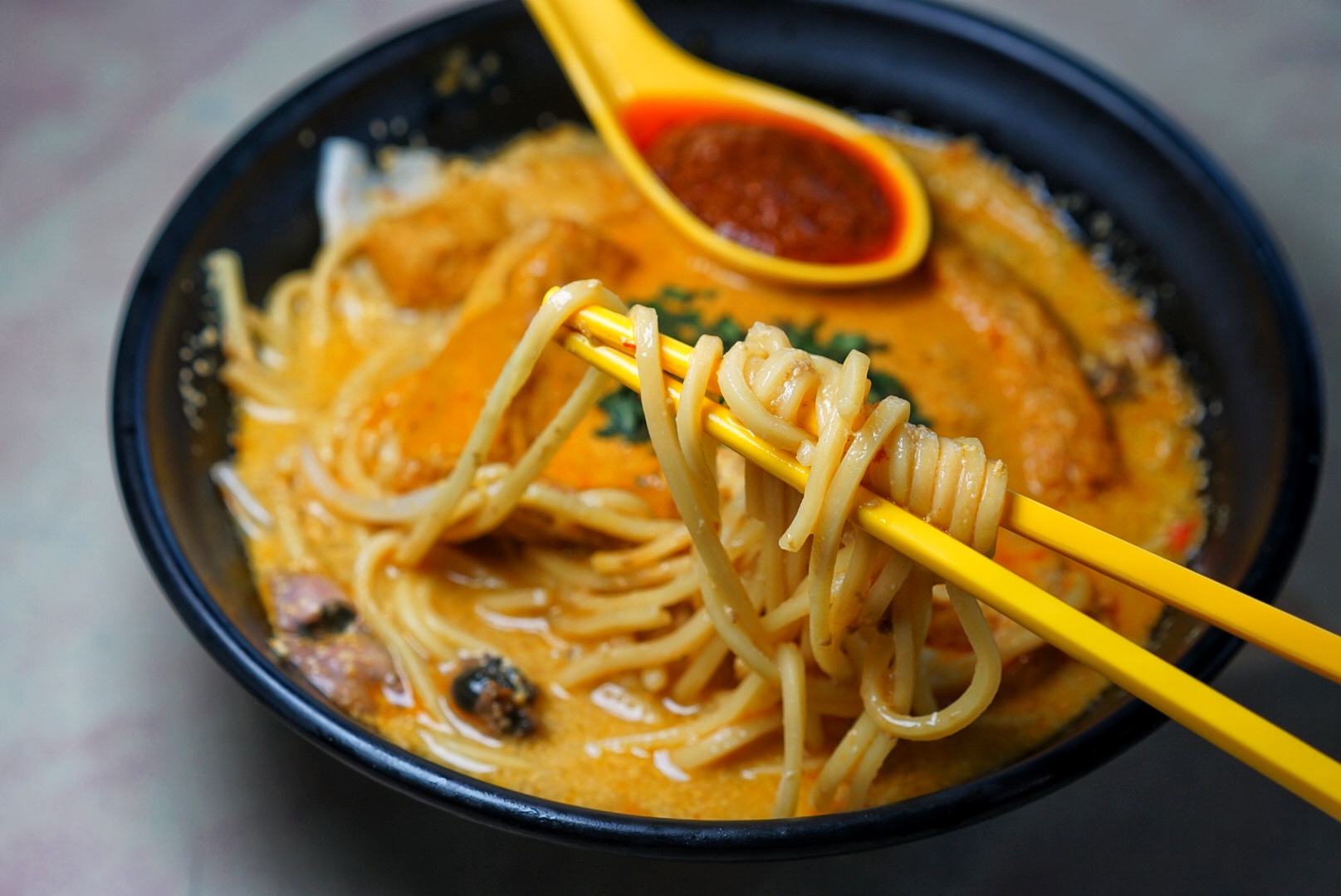
November 1, 2025
Updated November 17, 2025
Singapore boasts the optimal balance of affordable hawker center eats and Michelin star dining – reflecting this young country’s multicultural heritage of Chinese Malay, Peranakan, and Indian influences – coupled with one of Asia’s most happening bar scenes.

Gardens by the Bay
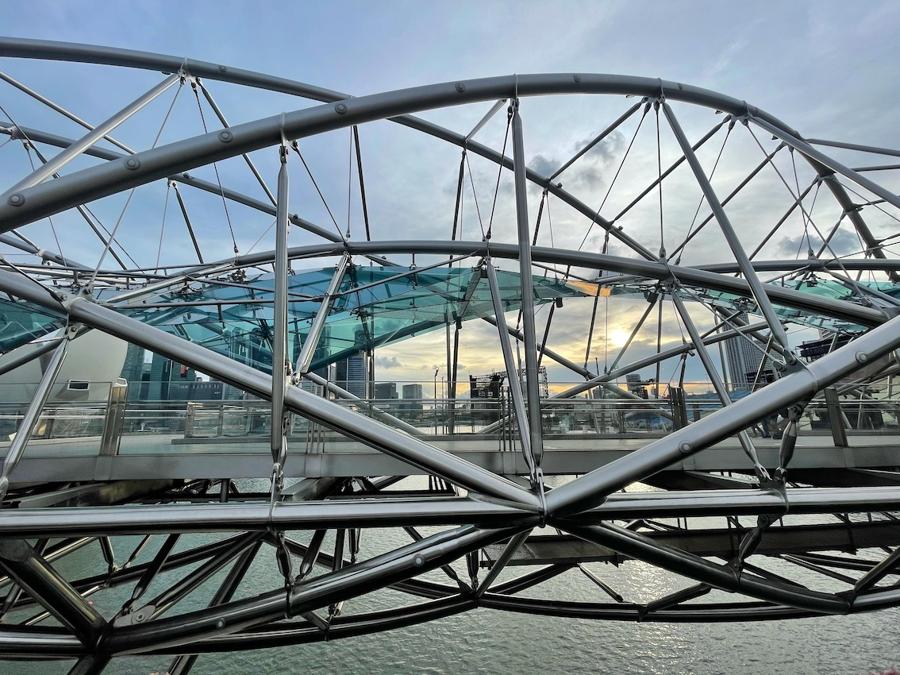
Helix Bridge
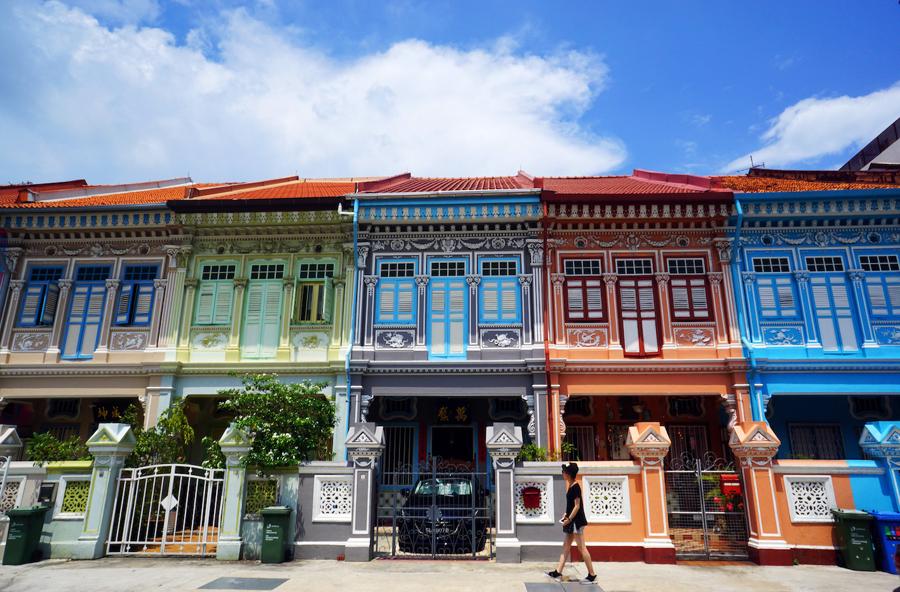
Joo Chiat
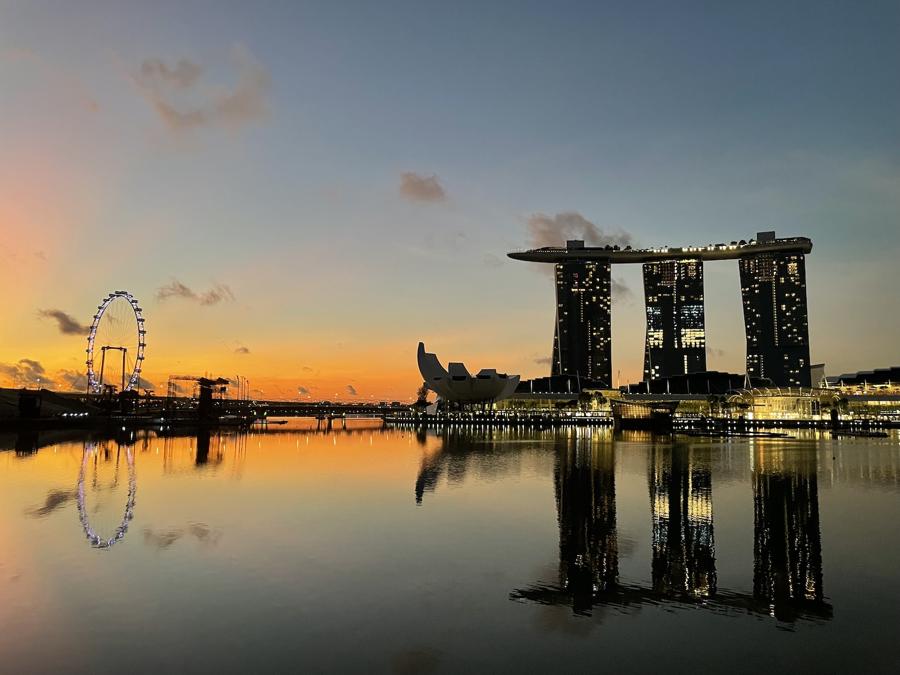
Marina Bay Sands
The heart of Singapore’s food culture, the aforementioned hawker center (an open-air, centralized food court of sorts), features numerous stalls under one roof that serve regional dishes. Even UNESCO has recognized hawker culture on its Intangible Cultural Heritage list, highlighting its importance to the community and city. From Hainese chicken and rice to Indian roti prata, from Malaysian nasi lemak to local chili crab, this city will have you feasting from dawn till dusk. Here's my guide of must-eat bites and where to try them in The Lion City.

Depot Road Zhen Shan Mei Laksa
Singapore laksa is a spicy noodle soup with a rich, creamy coconut milk-based broth laced with shrimp and chili paste, a staple of the nation's multicultural cuisine. It is a flavorful fusion of Chinese and Malay culinary traditions, featuring thick rice noodles (often cut for easy eating) served with ingredients like shrimp, fishcakes, and bean sprouts.
Where to get it:
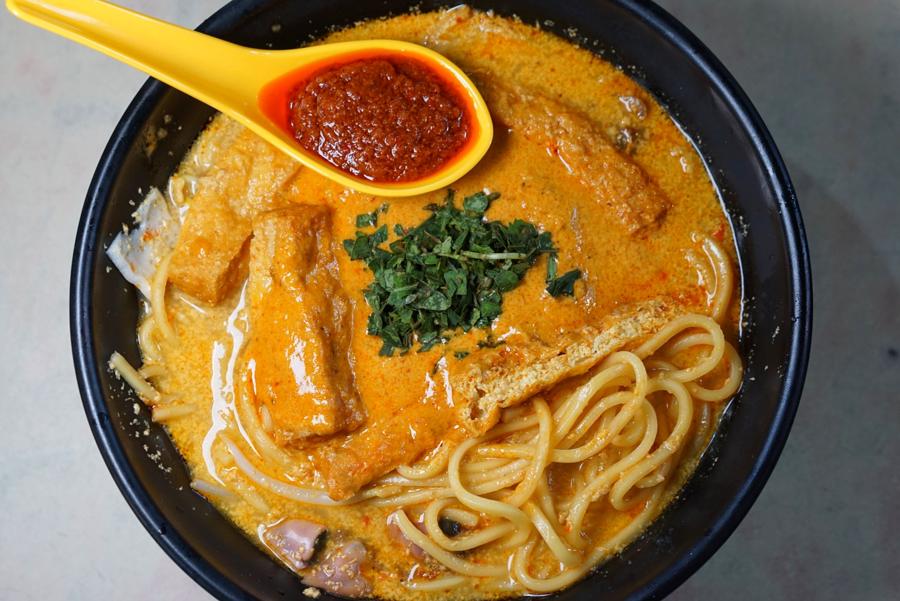
Depot Road Zhen Shan Mei Laksa
Depot Road Zhen Shan Mei Laksa: A renowned Singaporean stall for its claypot laksa, Depot Road Zhen Shan Mei Laksa claims a Michelin Bib Gourmand award. Originally located on Depot Road, the stall is now at Alexandra Village Food Centre, and is famous for its thick and luscious soup. The laksa is cooked in claypots, which keeps it piping hot and enhances the flavor.
120 Bukit Merah Lane 1, #01-75 Alexandra Village Food Centre, Singapore
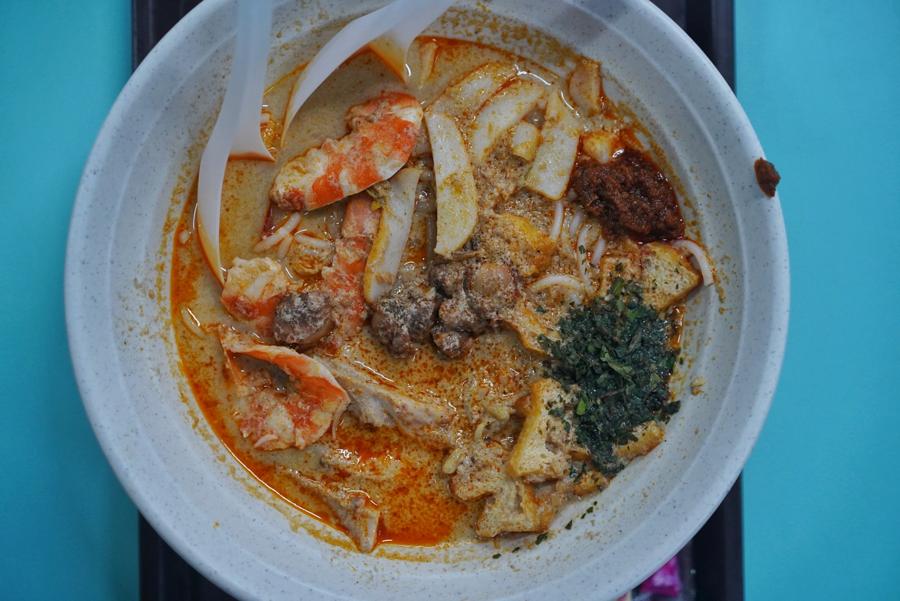
Sungei Road Laksa
Sungei Road Laksa: This food stall is celebrated for its traditional, charcoal-cooked laksa (that lends a smoky flavor) tempered by a coconut milk-based broth. The dish is a local institution, featuring thick rice noodles, springy fish cakes, briny blood cockles, and bean sprouts.
27 Jalan Berseh, #01-100, Singapore

Janggut Laksa
Janggut Laksa: This original Katong laksa stall traces its origins back to the 1940s, when owner Mr. Ng Juat Swee, nicknamed Janggut (meaning beard) for his long beard, sold laksa by carrying a pole with metal pots attached. He cut his noodles short to make it easier for patrons to eat quickly with just a spoon, a trademark of Katong laksa still today. The business has continued through family, with several locations around Singapore, each ladling out creamy coconut curry broth with ample seafood and chewy, short noodles.
50 E Coast Rd, #01-64 Roxy Square, Singapore
328 Katong Laksa: This Katong laksa eatery supplies hungry diners with a spicy coconut-milk noodle soup that gained it international fame in 2013 after defeating celebrity chef Gordon Ramsay in a cook-off challenge. The laksa is eaten just with a spoon (rather than chopsticks) as the noodles are thick, short rice vermicelli. The broth here is standout compared to other laksa shops, but 328 does sometimes skimp on the seafood toppings.
50 E Coast Rd, #01-64 Roxy Square, Singapore
928 Yishun Laksa: A family-run hawker stall near Yishun MRT, 928 Yishun Laksa serves affordable and authentic Singaporean coconut-based laksa. Here, patrons can enjoy it with thick bee hoon or yellow noodles, along with crab sticks, fishcakes and cockles. While typically crowded at peak times, the stall is praised for its generous portions, value for money, and authentic hawker atmosphere.
928 Yishun Central 1, #01-155, Singapore
Chatterbox: A Singaporean chain restaurant offering upscale takes on traditional hawker food, Chatterbox has everything from king prawns or lobster swimming in a spicy coconut gravy laksa to contemporary Hainanese chicken rice.
Level 5, 333 Orchard Road, Singapore
Singaporean chicken curry is a beloved, creamy, and mildly spicy soup that combines Indian, Malay, Chinese, and Eurasian culinary influences. There is no single "authentic" recipe, with countless home and hawker variations, but most versions feature an aromatic gravy with chicken and potatoes.
Where to get it:
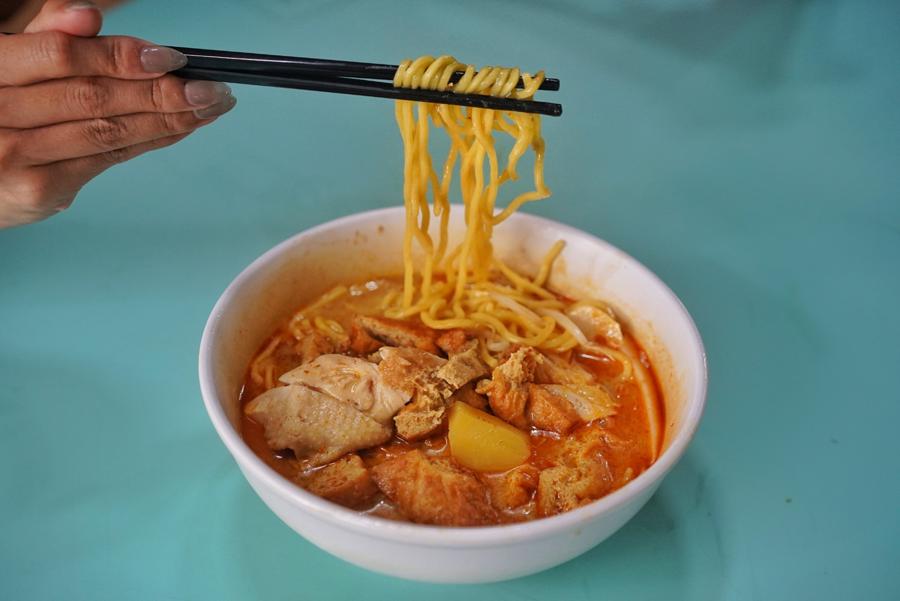
Ah Heng Curry Chicken Bee Hoon Mee
Ah Heng Curry Chicken Bee Hoon Mee: Quite possibly the best curry soup dish in all of Singapore, this Michelin recommended stall in the Hong Lim Food Centre doles out diner’s choice of rice vermicelli (bee hoon) or yellow noodles in a rich curry broth laden with succulent chicken, melt-in-your-mouth potatoes, fried bean curd that soaks up all the broth, and fish cakes. The chowder-like soup is delectably drinkable down to the very last drop with a perfect hint of spice. Despite the long queue, the line moves quickly, with friendly service to match.
531A Upper Cross St, #02-58/59 Hong Lim Market & Food Centre, Singapore
Prawn, fishball, and wonton noodles are distinct hawker dishes in Singapore, each offering a unique flavor profile, and available as either soup or a "dry" version tossed in a savory sauce.
For prawn noodles, it’s all about the flavor-packed prawn head and pork bone broth.
The best fishballs are handmade and bouncy, usually using yellowtail or Spanish mackerel.
And the wonton noodles come from a Cantonese delicacy, stuffed with minced pork and shrimp, and commonly paired with sliced char siu (roasted pork).
The noodles for all three of these dishes span the gamut: mee pok (flat egg noodles), mee kia (thin egg noodles), bee hoon (thin vermicelli), thick yellow noodles, and many more.
Where to get it:
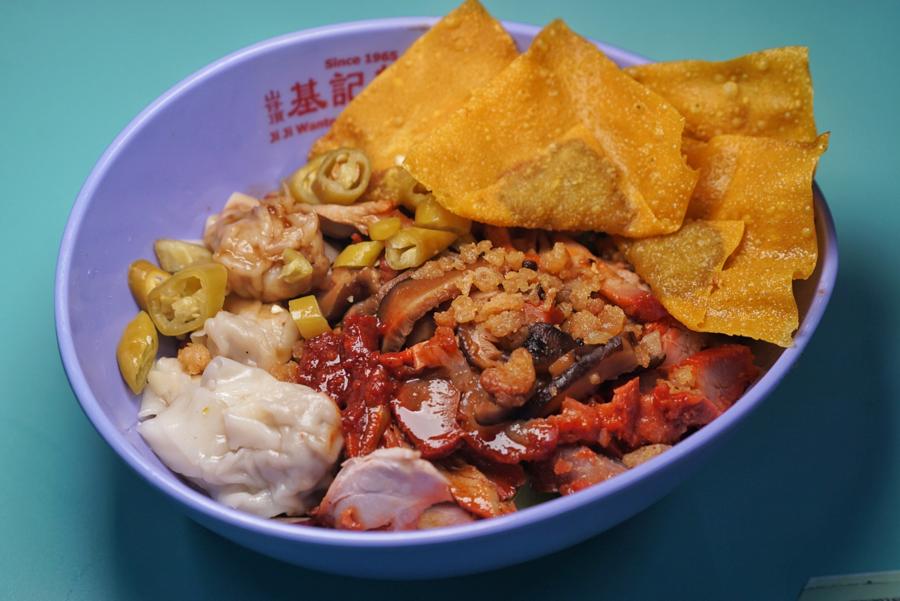
Jiji Wanton Noodle House
Jiji Wanton Noodle House: This multi-generational hawker stall in Singapore has earned a Michelin Bib Gourmand recommendation for its wanton noodles, which arrive tableside in generous portions, smothered in homemade dark soy-based sauce. Available in both dry and soup versions, the QQ texture squiggly noodles are crowned with substantial slices of char siew (roast pork), braised mushrooms, blanched greens, and both deep-fried and boiled wontons. The accompanying soup is often sweetened with goji berries and red dates for clean, finish.
Pro tip: Make sure to order the crispy chicken skin for added crunch.
531A Upper Cross St, #02-48/49 Hong Lim Market & Food Centre, Singapore

Da Shi Jia Big Prawn Me
Da Shi Jia Big Prawn Me: A Michelin Bib Gourmand-awarded eatery, this prawn noodle outpost serves Wok-Fried Big Prawn White Bee Hoon, replete with strong wok hei (breath of wok) aroma and umami-packed prawn stock. Patrons can choose soup or dry, noodle type, and size of prawns, ranging from regular to XXL. The restaurant is run by a younger generation, blending traditional local fare with a modern, trendy dining concept.
89 Killiney Rd, Singapore
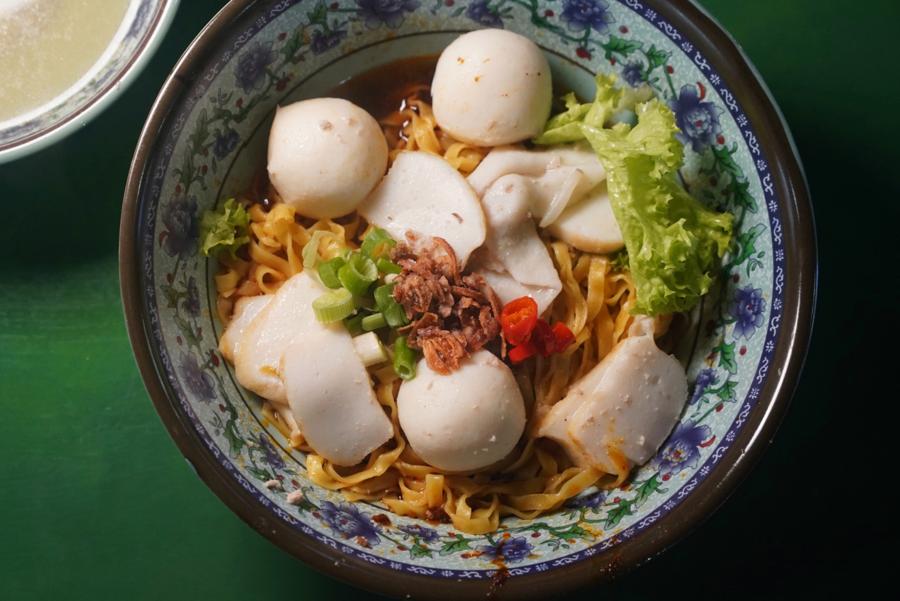
Sembawang Fishball Minced Meat Noodle (裕廊东18年传统味鱼圆面)
Sembawang Fishball Minced Meat Noodle (裕廊东18年传统味鱼圆面): A family-owned noodle stall in the Maxwell Food Centre, this underrated shop offers some fantastic Katong laksa as well as standout fishball noodles with that expert springy texture.
Maxwell Food Centre, 1 Kadayanallur St, #01-59, Singapore
Flat rice noodles and yellow wheat noodles are stir-fried in dark soy sauce and pork lard alongside cockles, shrimp, Chinese sausage (lap cheong), egg, and bean sprouts. A necessary component is the smoky "wok hei" flavor (aka “breath of the wok”), achieved by frying at extremely high heat. It traces its roots to Teochew culinary origins, with the name deriving from Hokkien words for "stir-fried" (char) and "flat rice noodles" (kway teow).
Where to get it:

Hill Street Char Kway Teow
Hill Street Char Kway Teow: The poster child for wok hei-forward, saucy fried noodles, Hill Street Char Kway Teow is exactly what you want when it comes to Chinese-style fried noodles, chock-full of blood cockles, egg, fish cakes, sweet sausage, and chunks of crispy pork lard that lend depth of flavor. Here, each plate is cooked individually for that extra hit of smoke.
Chinatown Complex, 335 Smith St, #02-32, Singapore

No. 18 Zion Road
No. 18 Zion Road: A highly-regarded hawker stall, No. 18 Zion Road is famous for its smoky, moist, and sweet char kway teow, notable for its balanced dark sauce, high-skill wok-frying, and fresh ingredients like fish cakes, lap cheong, and plump cockles.
70 Zion Rd, #01-17 Zion Riverside Food Centre, Singapore

Outram Park Fried Kway Teow Mee
Outram Park Fried Kway Teow Mee: Although always busy (expect 45-60 minutes of wait time during the lunch hour), the Outram Park Fried Kway Teow Mee has less wok hei aroma and textural contrast. Stickier than other renditions, the noodle texture unfortunately misses out on the crispy fried sausage contrast since it’s not included here. If you’re into blood cockles though, this might just be the best char kway teow for you.
531A Upper Cross St, #02-17, Singapore
This wok -fried noodle dish is made with yellow noodles and rice vermicelli, combined with ingredients like prawns, squid, pork, and eggs in a prawn head and pork bone broth. It's typically flavored with that same aromatic "wok hei" (breath of the wok) and served with a squeeze of lime and a side of sambal chili for an extra kick. The dish's exact origins are debated but are believed to be rooted in post-war hawker culture and the Hokkien community.
Where to get it:

Swee Guan Hokkien Mee
Swee Guan Hokkien Mee: Combining charcoal-stir-fried yellow noodles and thin bee hoon rice noodles in a seafood stock, this prawn and squid topped noodle dish is adored for its gooey consistency. The addition of chili sambal and a squirt of calamansi bring all the flavors of the wok together into one addictingly crushable bite.
549A Geylang Road (Geylang Lorong 29), Singapore
Chili Mee is a Malaysian hand-pulled wheat noodle dish with spicy homemade chili sauce, minced pork, poached eggs, fried anchovies, and leafy vegetables. Diners can enjoy it dry, with the chili sauce tossed into the noodles for a robust flavor, or in a soup version.
Where to get it:
Chung Cheng Chili Mee: A vivacious hawker stall in Golden Mile Food Centre, Chung Cheng Chili Mee serves its namesake dish of chili mee with yellow noodles topped with a generous amount of secret-recipe chili paste, pork ribs, prawns, fish cakes, bean sprouts, tofu puffs, fried pork skin, and a hard-boiled egg in an herbaceously sweet broth.
505 Beach Rd, #01-59, Singapore
Bak Chor Mee is another noodle dish tossed in a sauce of chili, vinegar, and pork lard, and a side of soup. Key ingredients include minced pork, sliced pork, meatballs, and liver, with variations often including mushrooms, wontons, and dried or fried sole fish. The dish can be prepared "dry" (tossed in sauce) or with soup, and customers can choose their preferred noodle type, such as flat mee pok or thinner mee kia.
Where to get it:

Hill Street Tai Hwa Pork Noodle
Hill Street Tai Hwa Pork Noodle: This historic, Michelin-starred hawker stall is prized for its bak chor mee. Founded in the 1930s, it regularly sees long queues to get a taste of the legacy passed down through generations. The dry noodles are tossed in a vinegary sauce, while the soup version has a milder seafood broth.
466 Crawford Ln, #01-12, Singapore
Blanched yellow egg noodles are smothered in a thick savory-sweet gravy, garnished with hard-boiled egg, bean sprouts, fried tofu, fried shallots, and a squeeze of lime. The dish's defining characteristic is its hearty gravy, naturally thickened with sweet potato and flavored with spices, shrimp, and anchovies.
Where to get it:
Afandi Hawa & Family Mee Rebus: This second-generation hawker stall specializes in mee rebus, a dish of rich, sweet and savory gravy made with shrimp, flower crab, and mutton, thickened with sweet potato puree, yellow noodles, a boiled egg, and garnishes like green chili and spring onions. The stall has a long history, founded by the owner's father in 1967, and is a great option for trying this unsung Singaporean classic.
14 Haig Rd, #01-21, Singapore
Chili crab is a signature Singaporean seafood dish of stir-fried mud crabs in a thick, sweet, savory, and spicy tomato-based sauce, often with a creamy egg gravy. It was created in the 1950s by Cher Yam Tian, who started selling it from a pushcart before opening the now-famous Palm Beach Restaurant. The dish is a national icon, popular with locals and tourists, and available in numerous seafood restaurants and stalls across the country.

Keng Eng Kee (KEK) Seafood's Chili Crab
Where to get it:
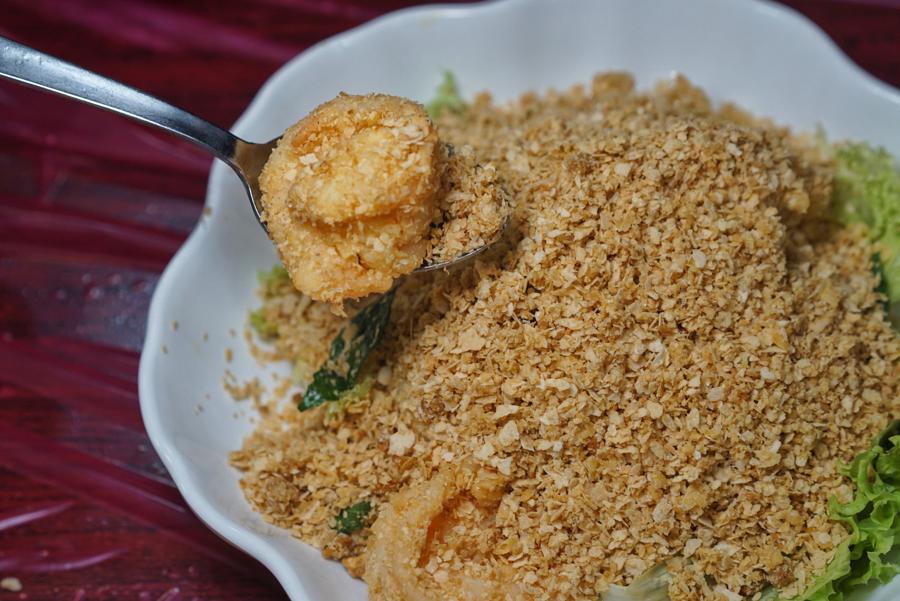
Keng Eng Kee (KEK) Seafood's Cereal Prawns
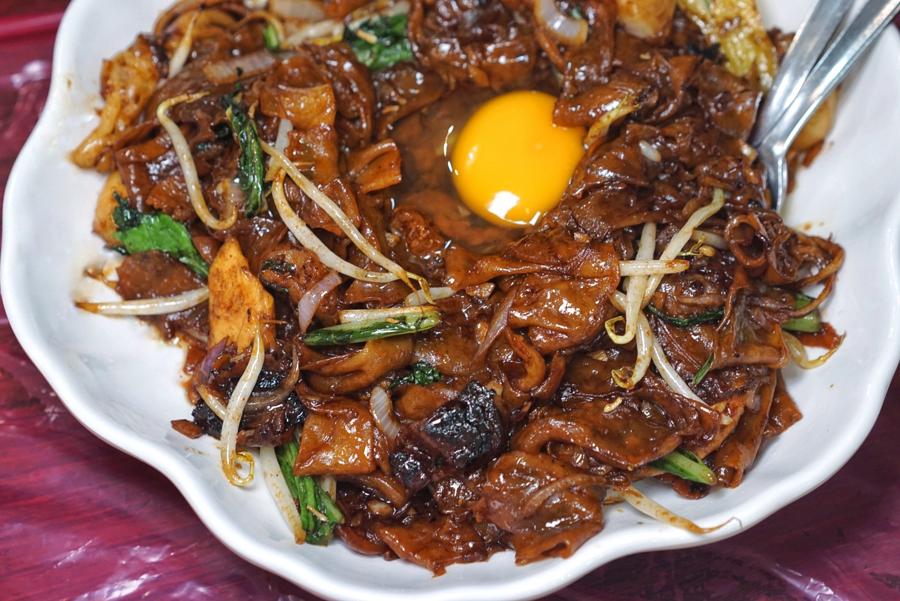
Keng Eng Kee (KEK) Seafood's Hor Fun
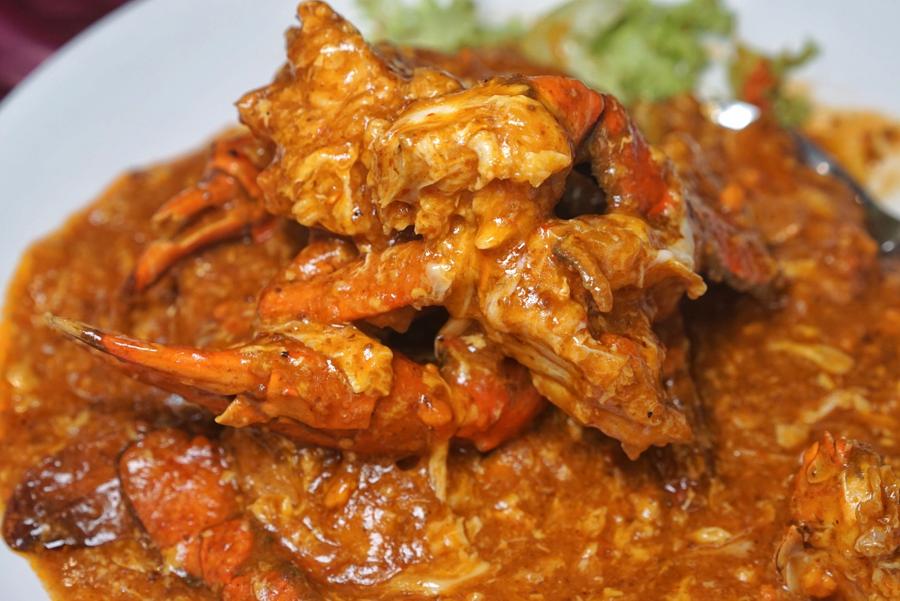
Keng Eng Kee (KEK) Seafood's Chili Crab
Keng Eng Kee (KEK) Seafood: An institution, this family-run zi char (cook-and-fry) style Chinese restaurant has been serving up seafood to the Singapore hungry masses for over 50 years. What began as a hawker stall is now a third-generation restaurant, overflowing with guests every night of the week. Come for the chili crab, but stay for the salted egg yolk squid, cereal prawns, crab and sambal fried rice, fried hor fun noodles, coffee pork ribs, sweet and sour fish, fish head curry, sambal kangkong, and salted egg yolk fried fish skin. You really can’t go wrong here; so make sure to come hungry and bring as many friends as possible.
124 Bukit Merah Lane 1, #01-136, Singapore
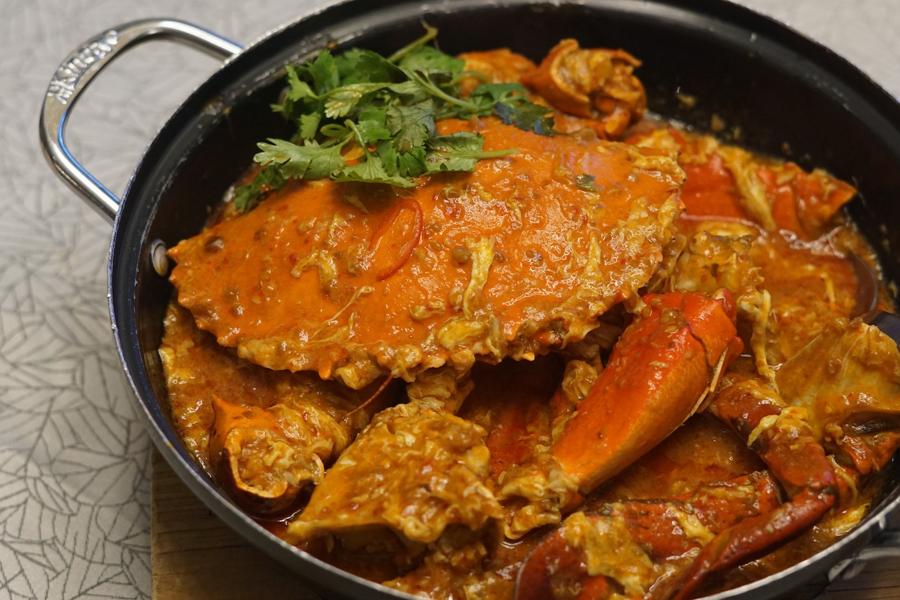
Jumbo Seafood
Jumbo Seafood: A Singaporean chain founded in 1987, this crab mecca proffers several crab-centric dishes, most notably chili crab and black pepper crab. It has grown from a single outlet into a revered brand with multiple locations in Singapore and international franchises in Asia.
30 Merchant Rd, #01-01/02 Riverside Point, Singapore
Fresh stingray fillets are coated in a spicy sambal chili paste, wrapped in a banana leaf, and grilled over charcoal for a smoky flavor. A squirt of calamansi cuts through the richness. Stingray has a firm texture that shreds like pulled pork and a mild flavor, falling somewhere between chicken and fish. It’s non-fishy flavor readily absorbs the smoky char of the grill and tangy sambal sauce, making it a must-eat while in Singapore.
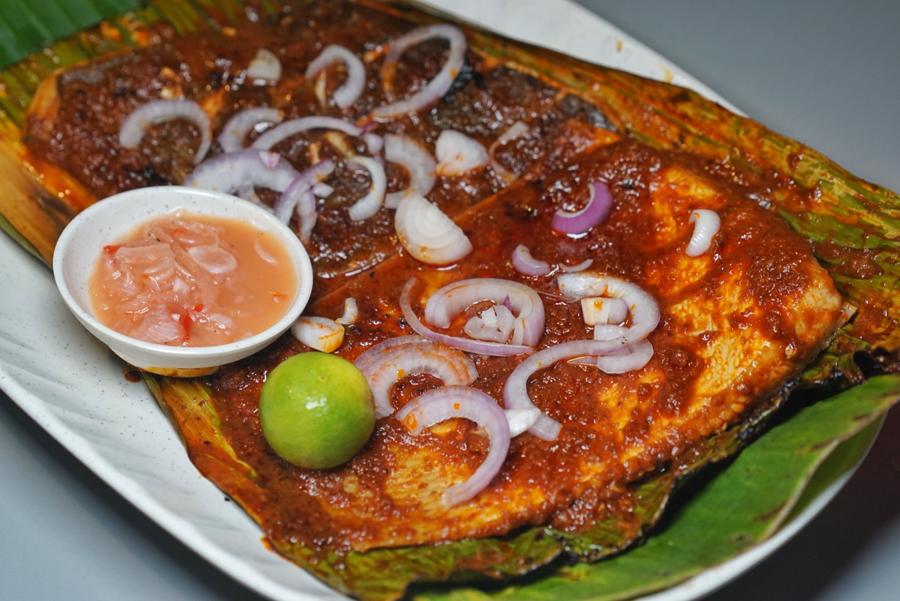
Hai Wei Yuan
Where to get it:
Hai Wei Yuan: A favored food stall in Chomp Chomp Food Court for BBQ stingray, this spot is a must-visit for seafood lovers.
20 Kensington Park Rd, #01-01 Chomp Chomp Food Centre, Singapore
Seafood Alliance: Newton Food Centre’s stall #27 is a long-standing hawker stall recognized by the Michelin Guide for its affordable, quality seafood. Aside from noteworthy sambal stingray, this is also a fantastic spot to try to chili crab, black pepper crab, cereal prawns, and other seafood.
500 Clemenceau Ave N, #01-27 Newton Food Centre, Singapore
Singapore’s national dish features tender, poached chicken served atop fragrant rice cooked in chicken broth and fat, with a side of chicken soup and fresh, sliced cucumbers. A myriad of chili sauce, soy sauce, and ginger-scallion sauce round out the plate. Originating from Hainanese immigrants, the dish is a ubiquitous meal found everywhere from hawker stalls to high-end restaurants.
Where to get it:
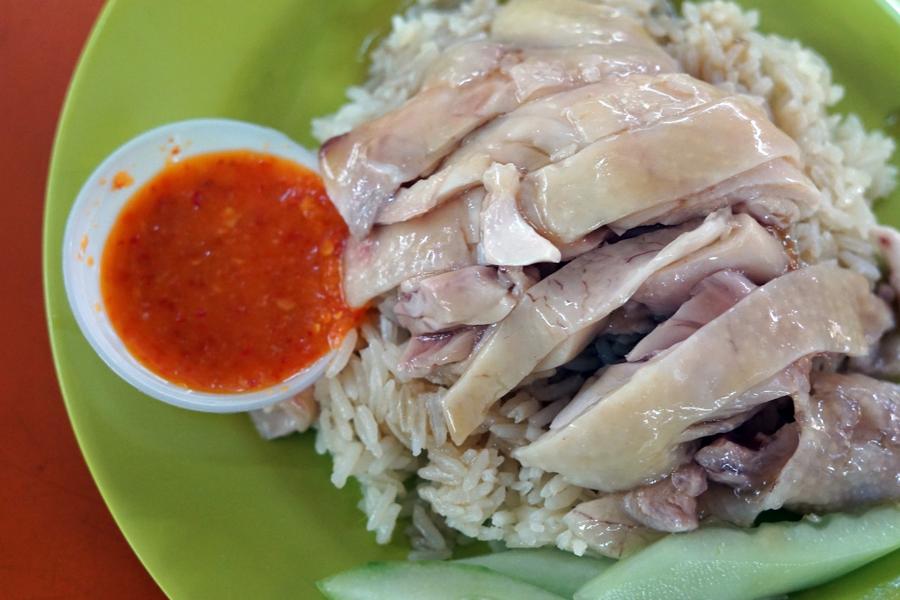
Tian Tian Hainese Chicken Rice
Tian Tian Hainese Chicken Rice: A globally-recognized eatery, this shop is home to succulent chicken atop fluffed rice, drawing in long queues at all hours. Silky chicken skin, moist flesh, flavorful rice cooked in chicken stock and fat, and secret recipe chili and ginger-scallion sauces together culminate in Singapore’s national dish.
1 Kadayanallur St, #01-10/11 Maxwell Food Centre, Singapore
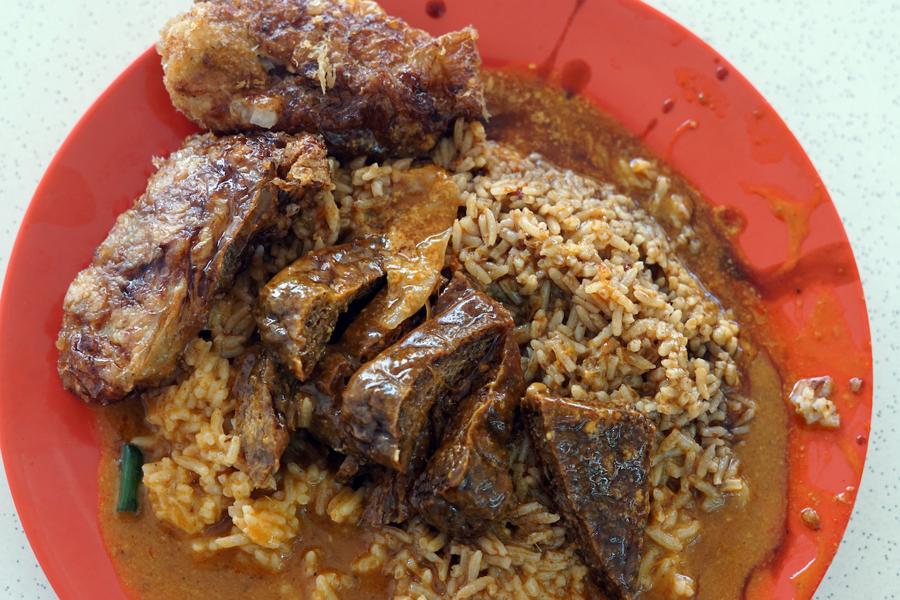
Beach Road Scissor Cut Curry Rice
Beach Road Scissor Cut Curry Rice: This is a favored diner for its Hainanese curry rice, presented in a casual, no-frills setting. The name comes from the practice of chopping ingredients, like pork chops and cabbage, with scissors before serving them over rice drenched in a thick and nutty spiced curry gravy, often mixed with a savory braised pork sauce. It's a go-to late-night supper spot, open until the wee hours of the morning. To order, simply point at a myriad of add-ons on display – from meat to veggies to tofu puffs (a must!) to fish cakes to spring rolls – and they will cut it up, put it over rice and smother it in gravy.
229 Jalan Besar, Singapore

Loo’s Hainese Curry Rice
Loo’s Hainese Curry Rice: This legendary hawker spot has been serving authentic, albeit messy, comforting plates of curry rice since 1946. The mild curry sauce is aromatic, but not overly thick, made with freshly squeezed coconut milk. The breadcrumb-coated pork chop is a signature, along with chap chye (Peranakan braised cabbage) and braised pork belly.
30 Seng Poh Rd, #02-67/68, Singapore
Charcoal-grilled, marinated meat skewers dipped in a flavorful peanut sauce, eating satay, particularly in an open-air setting, is a cherished tradition in Singapore.
Where to get it:

Kwong Satay
Kwong Satay: Originating from a grandfather’s satay stall in the 1960s, this Singaporean mainstay offers a variety of satay in a traditional Hainese marinade of sweet and savory spices. The thick peanut dipping sauce is laced with pineapple for a sweet balance. The grilled pork belly is a must-order, but any of the five meat varieties are a win.
Pro tip:Don’t skip the otah, a grilled fish cake made with tapioca flour and wrapped in banana leaf.
517 Lor 27A Geylang, Singapore
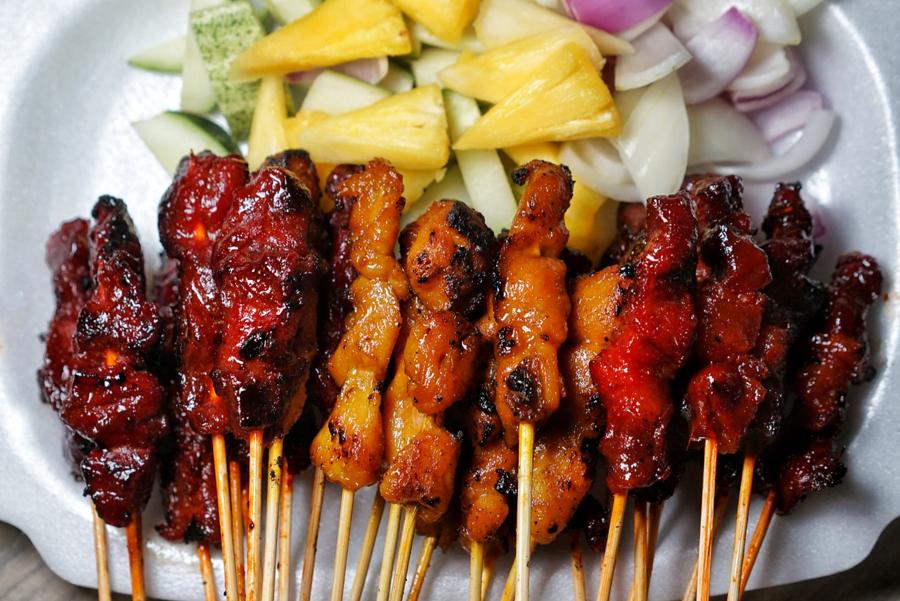
Haron 30 Satay
Haron 30 Satay: A buzzing halal satay skewers stall, the meat (chicken, beef, or mutton) at Haron 30 Satay is well-marinated, charcoal smoky, and tender, with a homemade Javanese-style peanut sauce, cucumber, onions, and ketupat (rice cakes). They also sell honey chicken wings at the Lagoon stall.
1550 Bedok North Ave 4, JTC Food City, #04-18, Singapore
Lau Pa Sat: A historic hawker center in Singapore, housed in a 19th-century Victorian building, Lau Pa Sat offers a mix of international food inside, and many satay (meat skewer) stalls outside in the evenings, with communal seating. While prices are a bit higher and the vibe can be described as more “foreigner friendly,” this is a centrally-located option for satay.
18 Raffles Quay, Singapore
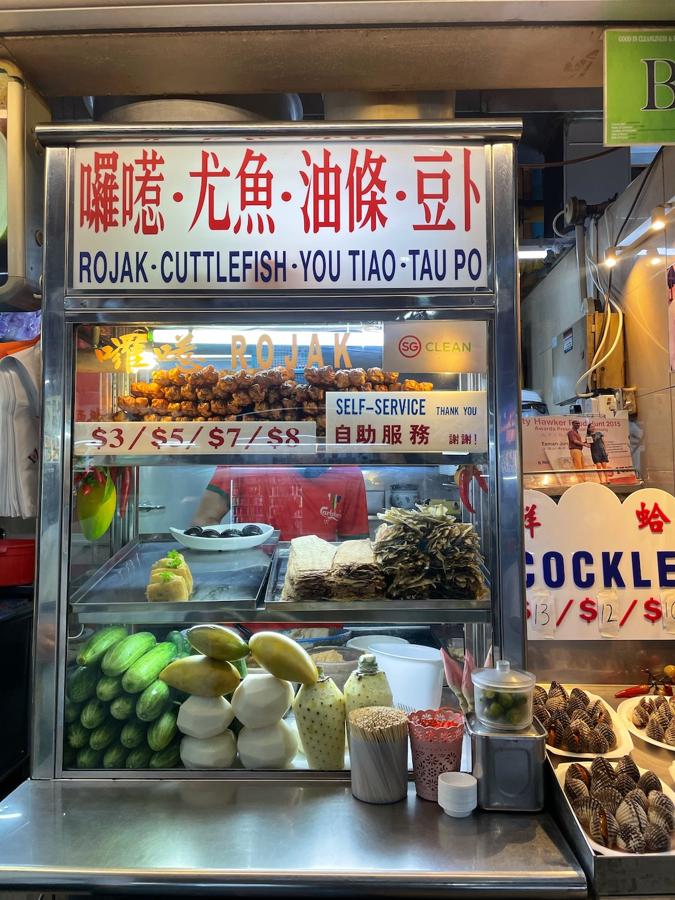
While every hawker center has its own personality and variety of cuisine, there are a few mainstays that can be found at nearly every one. There may be some variance in ingredients, recipe, and quality, however these snacks and side dishes can still be enjoyed all around town.
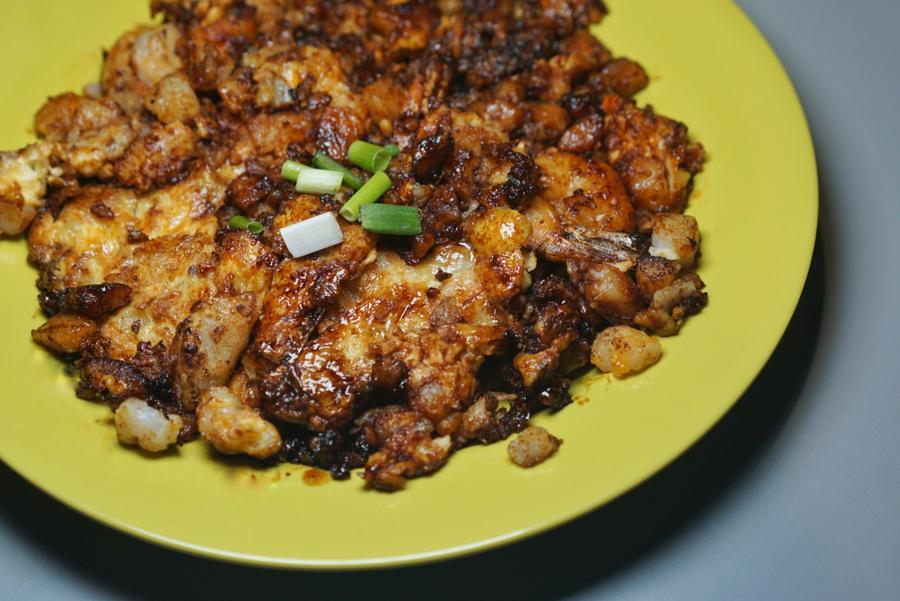
"Black" Carrot Cake
Not to be confused with the American-stye shredded carrot loaf cake customarily topped with cream cheese frosting, this savory griddle-fried pancake of sorts is instead made with daikon radish (translated as bai luobo 白萝卜 in Chinese, or white carrot, of which it’s girthy shape resembles). Singaporean carrot cake can be white – made with light soy sauce and usually crispier – or black – fried with dark soy sauce for an extra hit of umami.
Where to get it: Stall 40 at East Coast Lagoon Food Center or Newton Food Center stall #27
An local fruit and vegetable salad that embodies the nation's multicultural heritage, rojak blends Malay, Chinese, and Indian culinary influences. The name "rojak" literally means "mixed" in Malay, which aptly describes the dish's eclectic combination of ingredients and flavors. Expect to find some assortment of cucumber, pineapple, jicama, bean sprouts, green mango, water spinach, youtiao (deep-fried Chinese dough fritters) and taupok (toasted beancurd puffs) that soak up the sauce. The salad is tossed in a sticky sauce of fermented prawn paste, tamarind paste, palm sugar, chili, and lime, and garnished with crushed peanuts.
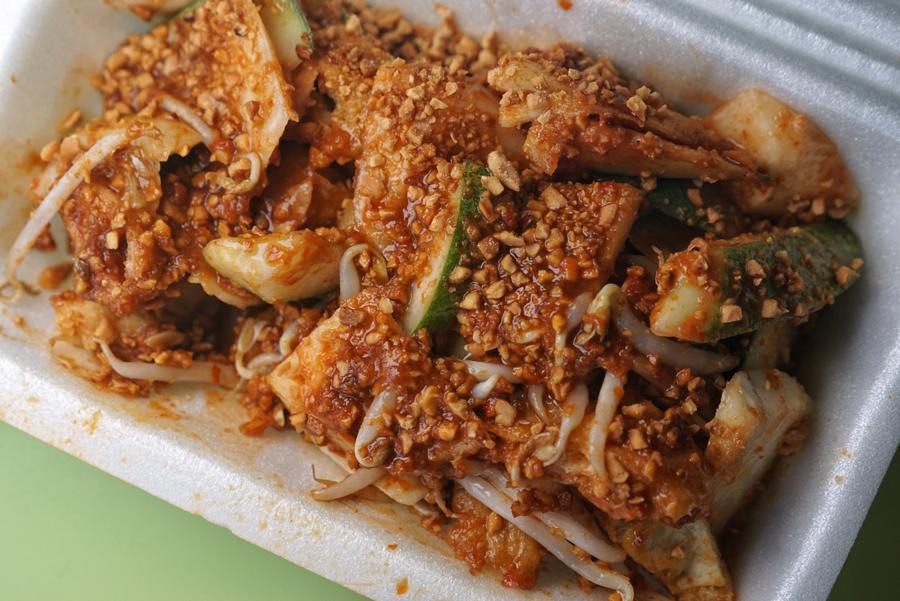
Rojak Salad
Where to get it: Singapore Famous Rojak (#01-45) at Albert Center
A non-fried Chinese (Hokkien/Teochew) spring roll enjoyed as a snack or light, popiah is made by wrapping a delicate, paper-thin wheat flour skin around a savory and moist filling of finely-shredded and slow-cooked jicama, carrots, bean sprouts, thinly sliced tofu, shredded omelet, and sometimes seafood, like prawns or crab. It’s customarily finished with ground peanuts or fried shallots for crunch.

Popiah
Where to get it: Ann Chin Popiah
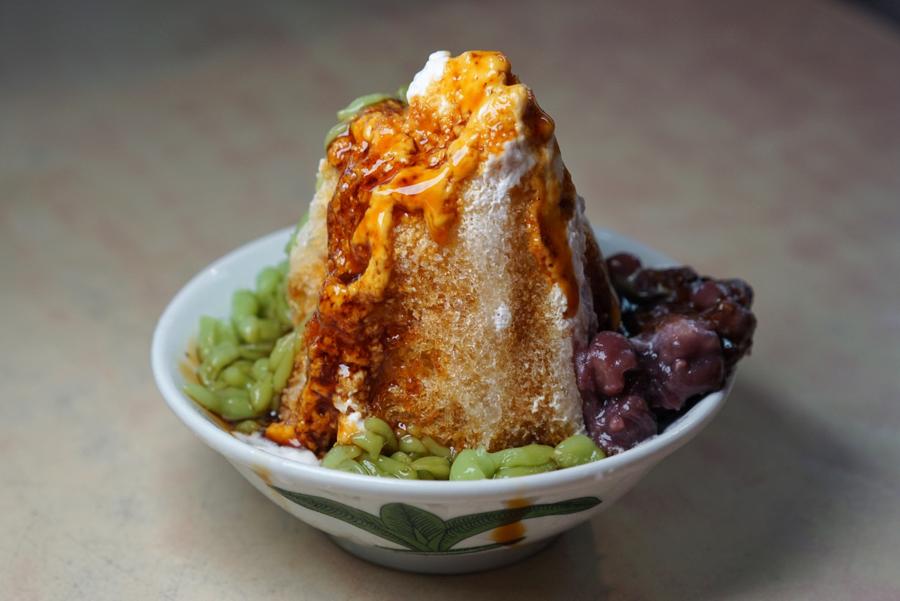
Ice Kacang
Also known as "ABC" (Ais Batu Campur or "mixed shaved ice"), ice kacang consists of a mound of finely shaved ice topped with a colorful variety of jellies, red beans, sweet corn, and palm seeds, all drizzled with rose syrup or gula melaka (palm sugar), and a generous amount of condensed or evaporated milk, making it a sweet, cool, and refreshing treat.
Where to get it: Old Airport Road stall 01-115, Berseh Food Center, Liang Liang Garden in Tiong Bahru Market
Another shaved ice dessert, cendol starts with a generous mountain of fluffy, finely shaved ice topped with pandan jellies, freshly pressed coconut milk, and gula melaka syrup that lends a necessary smoky, caramel sweetness. Other optional add-ons span sweet red beans, durian, sweet corn, palm fruit seeds, and glutinous rice.

Cendol
Where to get it: Old Airport Road stall 01-115, Old Amoy Chendol
A classic Singaporean breakfast, kaya toast begins with toasted bread slathered in butter and a sweet coconut-egg jam called kaya. It is often eaten with soft-boiled eggs and a local coffee (kopi) or tea, and is a staple in hawker centers and coffee shops.
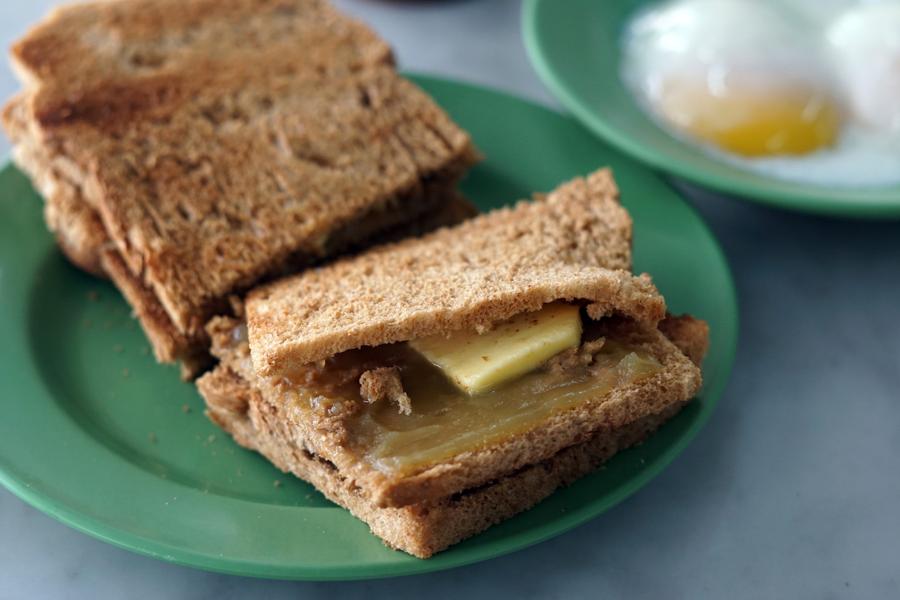
Kaya Toast
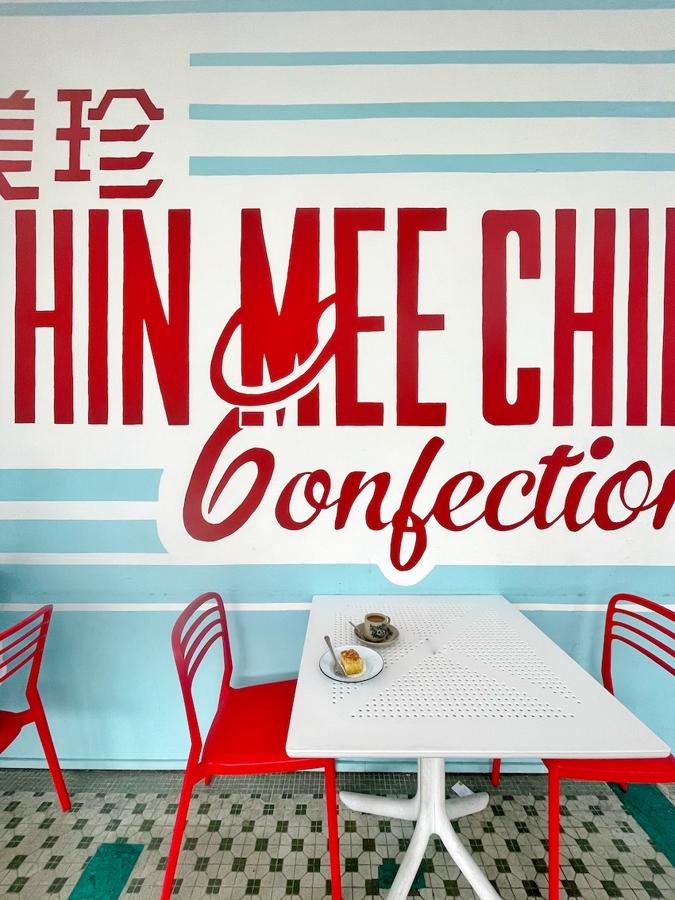
Where to get it: Ah Seng (Hai Nam) in Amoy Street Food, Ya Kun Kaya Toast, Chin Mee Chin Confectionary (also get the sugee cake here)
A Singaporean, Indonesian and Malaysian street pancake, apam balik (aka martabak manis) is thick, fluffy, and chewy with a distinct honeycomb structure, akin to the inside of a crumpet with crispy edges but a plush center. The batter is cooked in a round, deep pan, and the pancake is filled then folded for a hand-held snack. Conventionally it’s stuffed with diner’s choice of sweet (and sometimes savory) fillings, like crushed peanuts, chocolate sprinkles, condensed milk, and/or shredded cheese.
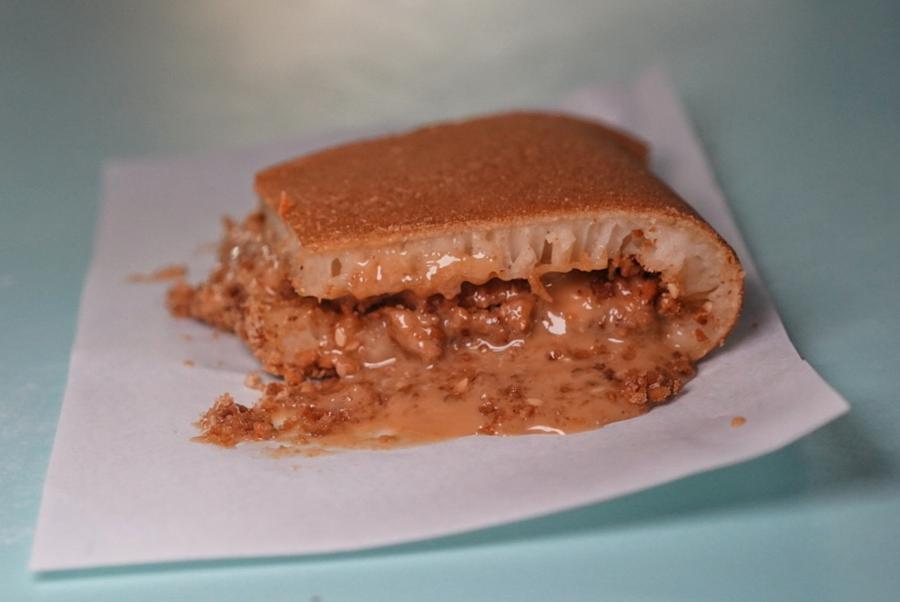
Granny's Pancake
Where to get it: Granny’s Pancake (#02-39) at Hong Lim Food Centre
Putu piring is a steamed, soft rice flour cake, traditionally filled with melted palm sugar (gula melaka) and served warm with freshly grated coconut and sometimes pandan leaf.

Putu Piring
Where to get it: Haig Road Putu Piring
Singapore has an wide spectrum of global cuisines primarily due to its history as a major international trading port and its resulting multicultural population. From the early 19th century, when the British established Singapore as a free port, immigrants from China, India, Malaya, Europe, and the Middle East flocked to the island for work and a better life. They each brought their distinct culinary traditions, ingredients, and cooking techniques, laying the foundation for a diverse food scene. Today, food is viewed as crucial to Singapore's national identity, serving as a unifying cultural thread that celebrates its cross-cultural heritage.
Indians make up about 9% of Singapore's resident population, making them the third-largest ethnic group after Chinese and Malay. Indian cuisine in Singapore sees influences from North India, South India, and Tamil Muslim traditions, adapted with local influences. It ranges from classic dishes like dosa and fish head curry to local adaptations like Indian rojak, and is available everywhere from hawker centers to upscale restaurants.

Mr. Appam
The place to start for sampling a variety of Indian dishes in Singapore is Little India, near the Tekka Center. Aside from ample offerings of vegetarian-friendly Indian restaurants there are also many Indian dessert shops and south Indian food outposts serving banana leaf meals.
Where to get it:
Peranakan cuisine, also known as Nyonya cuisine, is a blend of Chinese ingredients with Malay cooking styles, influenced by other cultures like Indonesian and Indian. This Singaporean cuisine is complex, tangy, and spicy, often using ingredients like galangal, chilies, and shrimp paste, and features classic dishes such as ayam buah keluak and laksa. Developed over generations by the Peranakan people, descendants of early Chinese immigrants who intermarried with local Malays, it is a cornerstone of Singapore's cultural heritage, originally passed down through family recipes.
Where to get it:
Prized for its bold, spice-driven flavors and diversity stemming from the Indonesian archipelago's many regional culinary traditions, Indonesian cuisine in Singapore sees many offerings. Dishes range from fiery Padang-style curries to Javanese street food, appealing to both locals and the significant Indonesian community.
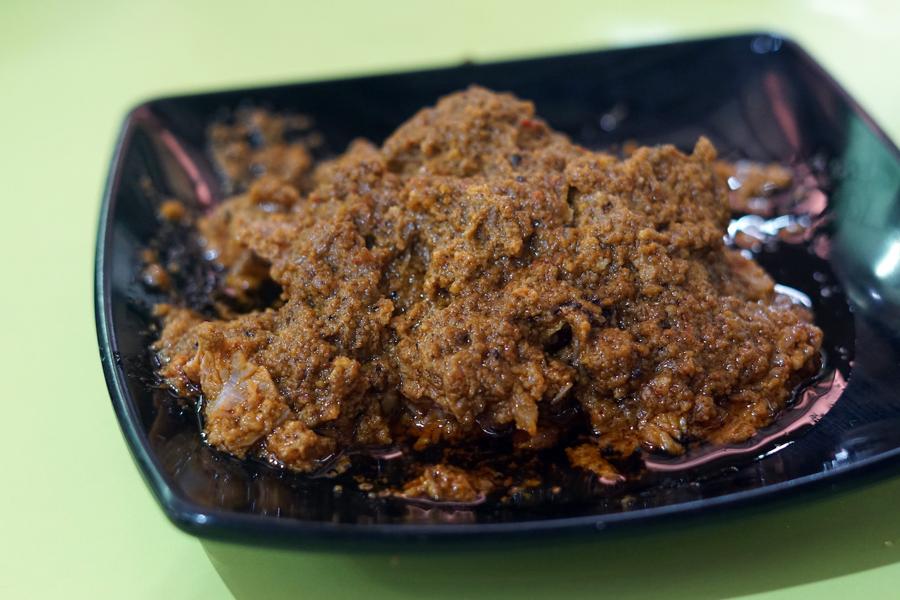
Sinar Pagi's Beef Rendang
Where to get it:
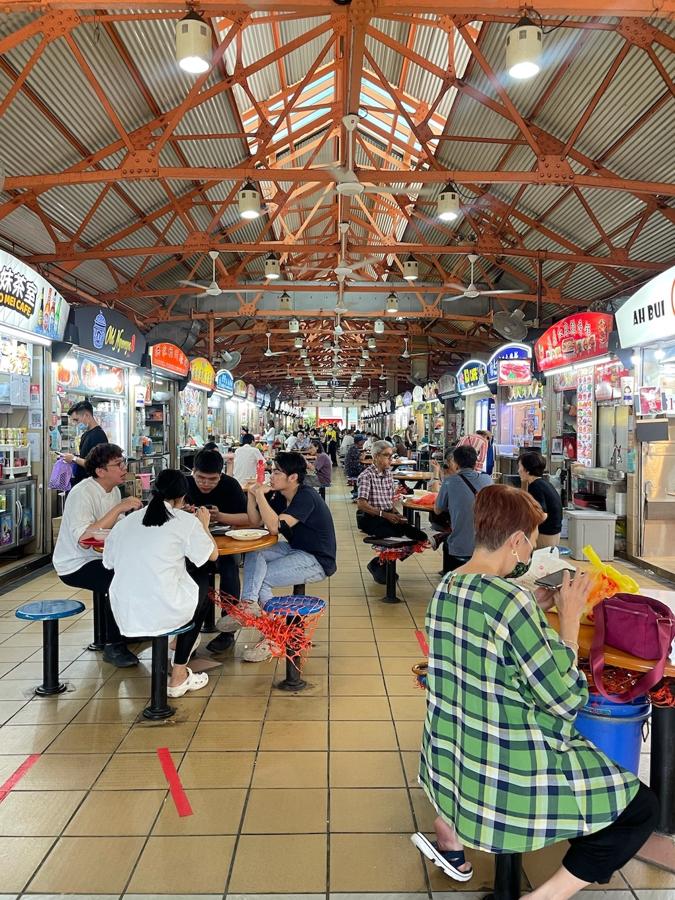
Singapore's hawker centers are iconic open-air complexes offering affordable, high-quality local cuisine in a communal setting. Evolved from a history of unhygienic street-food vending, these government-regulated hubs have become a cornerstone of Singaporean life and are recognized by UNESCO as an Intangible Cultural Heritage of Humanity. Here are some of the city’s most bustling options:
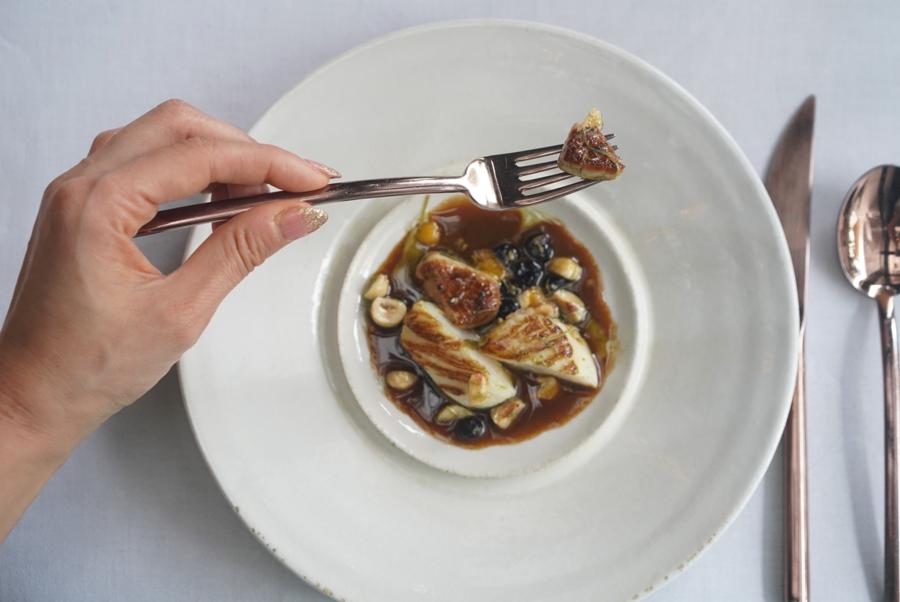
Zén
Zén: Zén is a three-Michelin-star Neo-Nordic restaurant, where diners are welcomed into a homey setting and treated to an eight-course Nordic, French, and Japanese influenced meal.
41 Bukit Pasoh Rd, Singapore
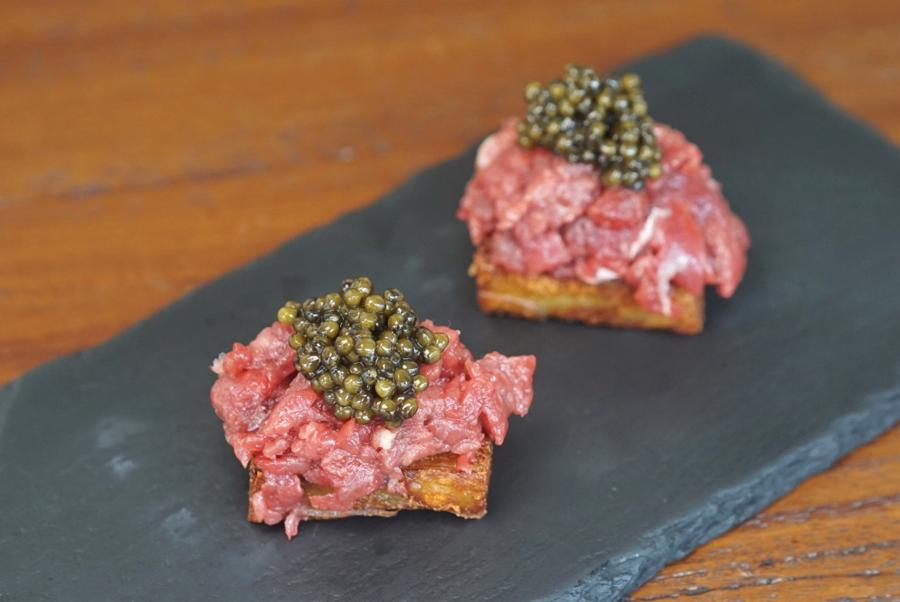
Burnt Ends

Burnt Ends
Burnt Ends: A modern, upscale Australian barbecue restaurant, Burnt Ends uses custom wood-fired brick ovens and elevation grills coupled with high-quality proteins for a casual yet refined Michelin-quality dining experience.
Pro tip: Make sure to stop at the Burnt Ends Bakery next door for some showstopper donuts and baked confectionaries.
7 Dempsey Rd, #01-02, Singapore
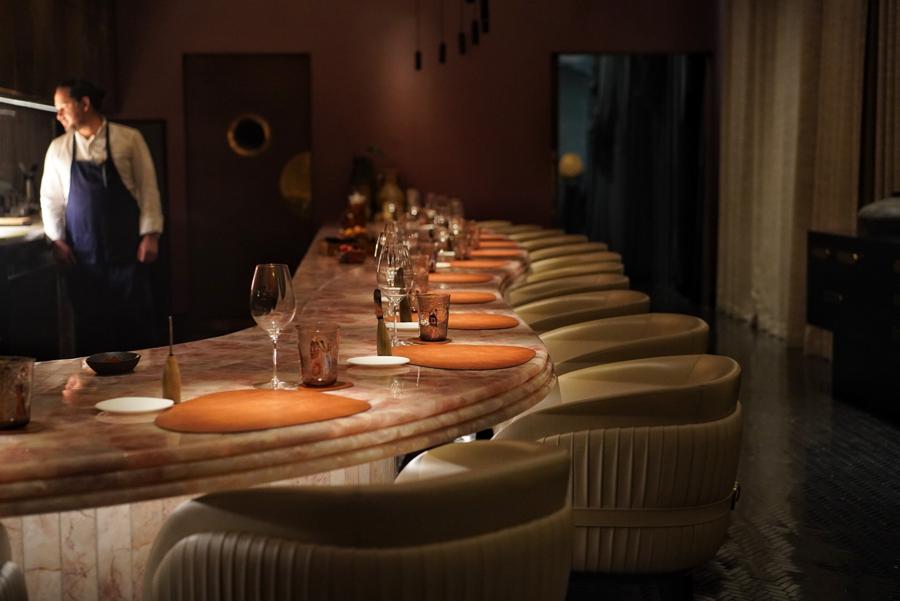
Araya
Araya: The world’s first and only Chilean Michelin-starred restaurant, the menu at Araya spotlights indigenous Chilean ingredients, spanning the Andes Mountains to the ocean’s coast, plus nods to Japanese culture and flavors, from produce to protein, owed to Chef Araya’s time spent there, where he earned his first Michelin star.
Mondrian Singapore Duxton 83 Neil Road, Duxton Hill, #01-08, Singapore

Bees by Narisawa
Bees by Narisawa: A casual dining concept by Japanese superstar chef Yoshihiro Narisawa, the menu sees elevated Japanese comfort fare using high-quality, sustainable ingredients.
31 Bukit Pasoh Rd, Singapore
As one of Asia’s most vibrant bar scenes, Singapore claims an eclectic mix of new standouts and tried-and-true fan favorites as diverse as the city’s international makeup. Here are a few must-visit watering holes:
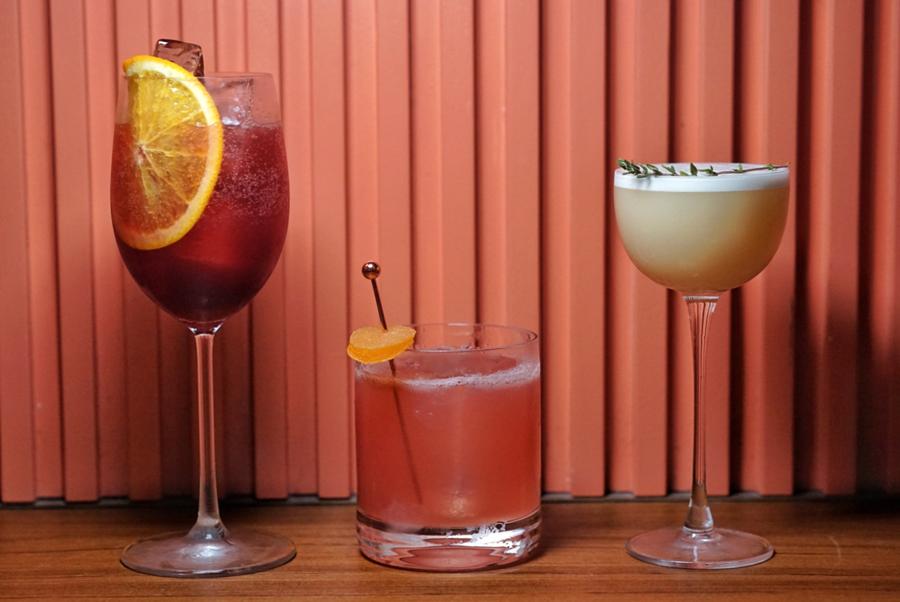
Jigger & Pony
Jigger & Pony: A top-ranked cocktail bar beloved for its creative and classic drinks, inviting ambiance, and genuine hospitality. Uno Jang, Jigger & Pony's Creative Director, most recently was awarded the Best Bartender by World's 50 Best bars.
165 Tg Pagar Rd, Amara Hotel, Singapore
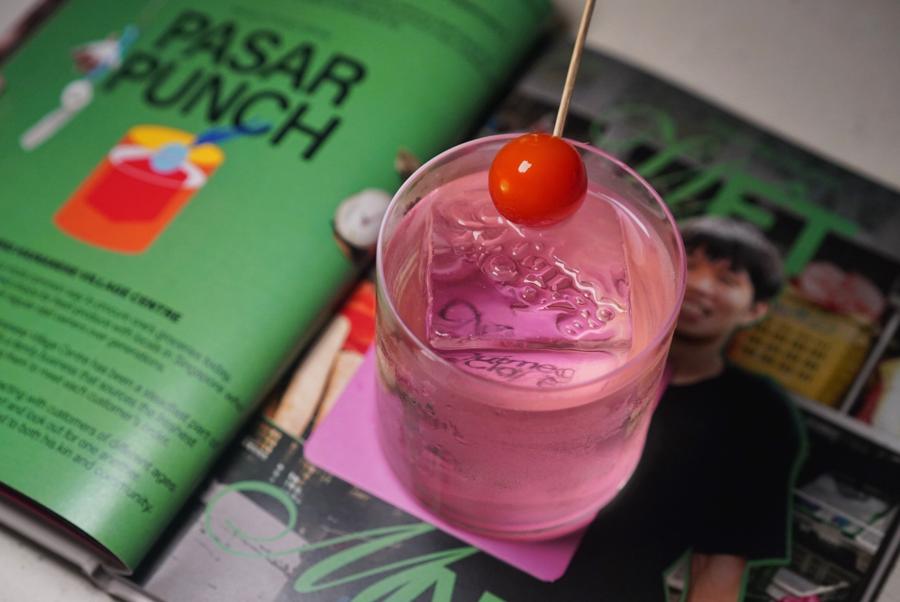
Nutmeg & Clove
Nutmeg & Clove: One of the bars to put Singapore’s cocktail scene on the global map, Nutmeg & Clove pays homage to the nation’s history through modern Singaporean cuisine and progressive cocktails. The new menu iteration highlights locals shop owners and vendors around town that make up Singapore’s varied makeup.
Pro tip: The Ikan Assam Pedas is stellar.
8 Purvis St, Singapore
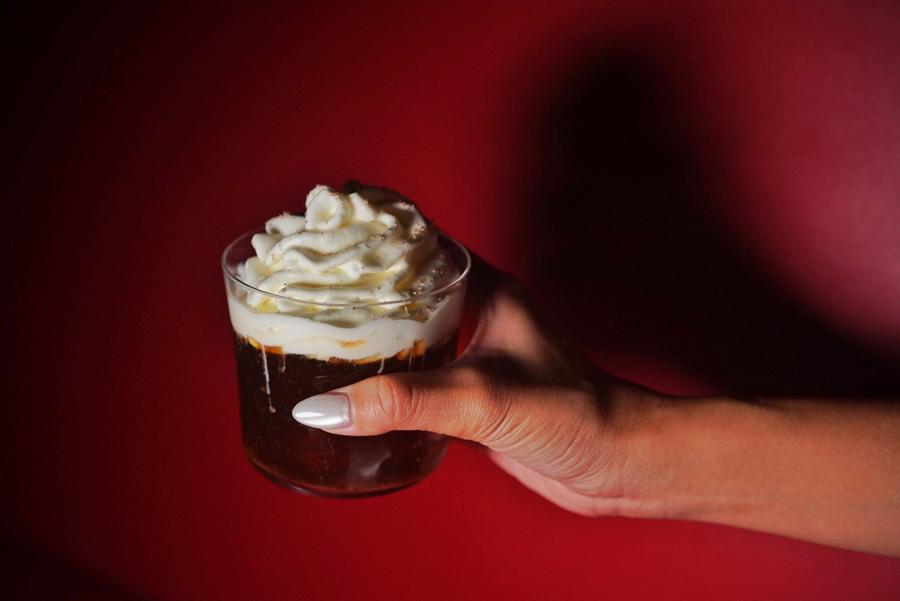
Cat Bite Club
Cat Bite Club: Sink your teeth into Singapore’s friskiest bar, a venue highlighting two well-loved categories deeply rooted in terroir: agave and rice spirits.
75 Duxton Rd, Singapore
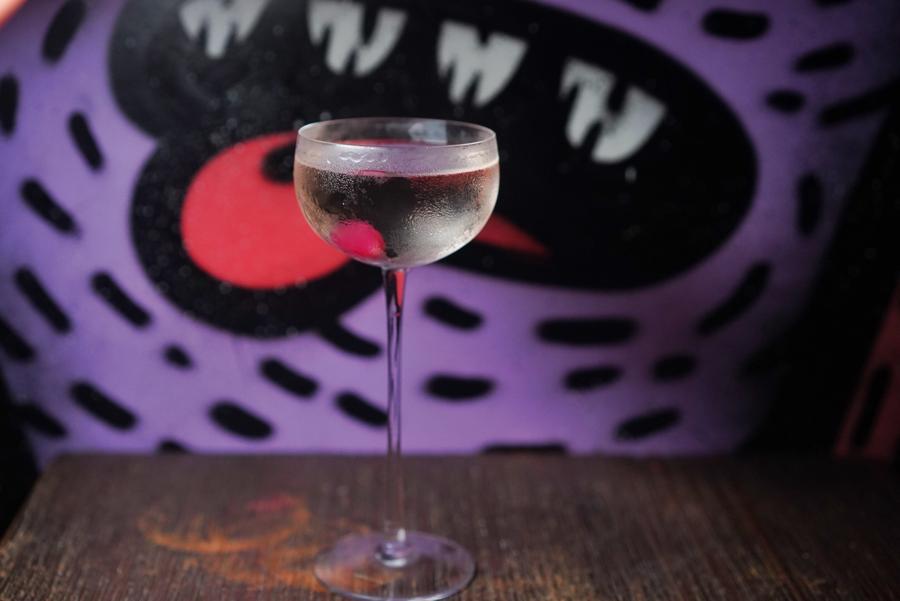
Sago House
Sago House: An industry favorite, Sago House shakes up six entirely new cocktails each week with standout hospitality, keeping it interesting for bar nerds and nobodies alike
37 Duxton Hill, Singapore

Elephant Room
Elephant Room: Celebrating all things India, the Elephant Room bases each cocktail on a specific Indian dish, spice, or flavor through homemade distillates, ferments, jellies, and more.
33 Tg Pagar Rd, #01-02, Singapore

Jungle Ballroom
Jungle Ballroom: Sporting a menu inspired by the team’s travels, each cocktail represents a different Asian city through local ingredients.
16A Duxton Hill, 16A, Singapore
Night Hawk: A 25-seat wraparound bar inspired by Edward Hopper’s iconic 1942 painting, Nighthawks, the bar takes a modern yet restrained approach to interiors, cocktail menu, and noteworthy music program.
43 Tg Pagar Rd, #01-02, Singapore
Live Twice: An ode to mid-century modern Japan, Live Twice is a nod to the golden era of 1960s post-war Tokyo, the drinks roster links to Nancy Sinatra’s 1967 track “you only live twice” and the seasons of Japan.
18-20 Bukit Pasoh Rd, Singapore

Manhattan
Manhattan: Inspired by the Golden Age of cocktails and old-world New York glamour, Manhattan’s menu pays tribute to The Big Apple’s culture and history
1 Cuscaden Rd, Level 2, Singapore
Atlas: An opulent, Art Deco-style bar with an extensive gin collection and sophistical cocktails, Atlas offers one of the most luxurious cocktail experiences in the entire country.
600 N Bridge Rd, Parkview Square, Singapore
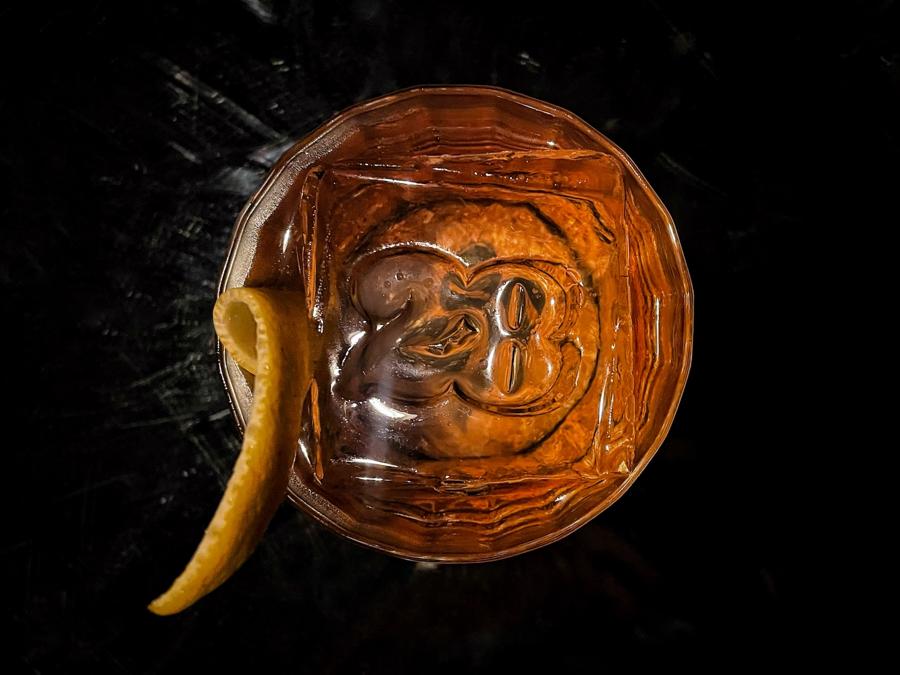
28 Hong Kong Street
28 Hong Kong Street: An American-style speakeasy known for pioneering the fine drinking movement in Singapore, 28 Hong Kong Street is an industry favorite, making it busy every weekend deep into the witching hour.
28 Hong Kong Street, Singapore
Fura: Fura is a sustainable cocktail bar built around the ethos of ecologically-balanced, future-forward drinks and plant-based food.
74A Amoy St, Singapore
Employees Only: A spin-off of the famed Employees Only NYC, this speakeasy pours award-winning cocktails and American cuisine.
112 Amoy St, Singapore
Stay Gold Flamingo: A dual concept venue, Stay Gold Flamingo operates as a coffee and wine bar called Flamingo by day and a rock-and-roll cocktail bar named Stay Gold by night.
69 Amoy St, Singapore
Native: A bar centered around sustainable use of local ingredients, Native is a three-story establishment with a restaurant, cocktail bar, and fermentation lab.
52A Amoy St, Singapore
To burn off all the eating and drinking that's bound to fill your Singapore itinerary, here are some must-visit destinations around the city.
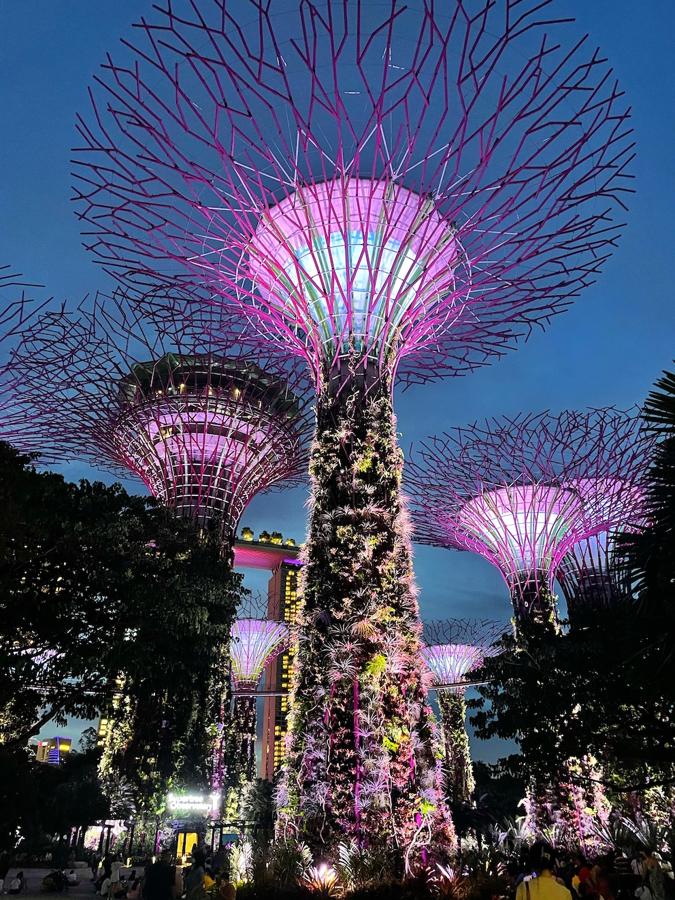
Gardens by the Bay

Marina Bay Sands
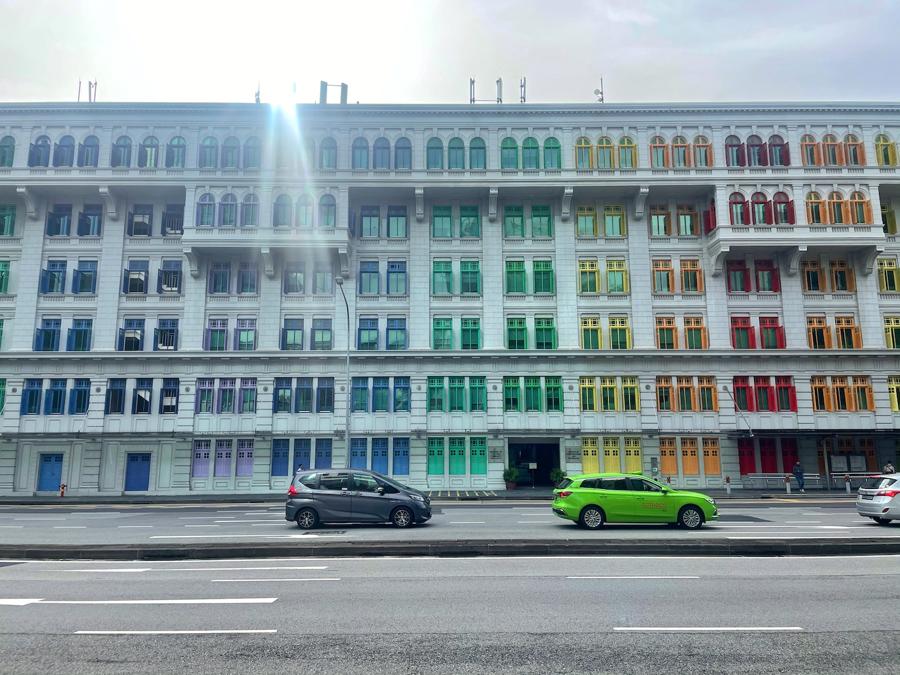
Old Hill Street Police Station
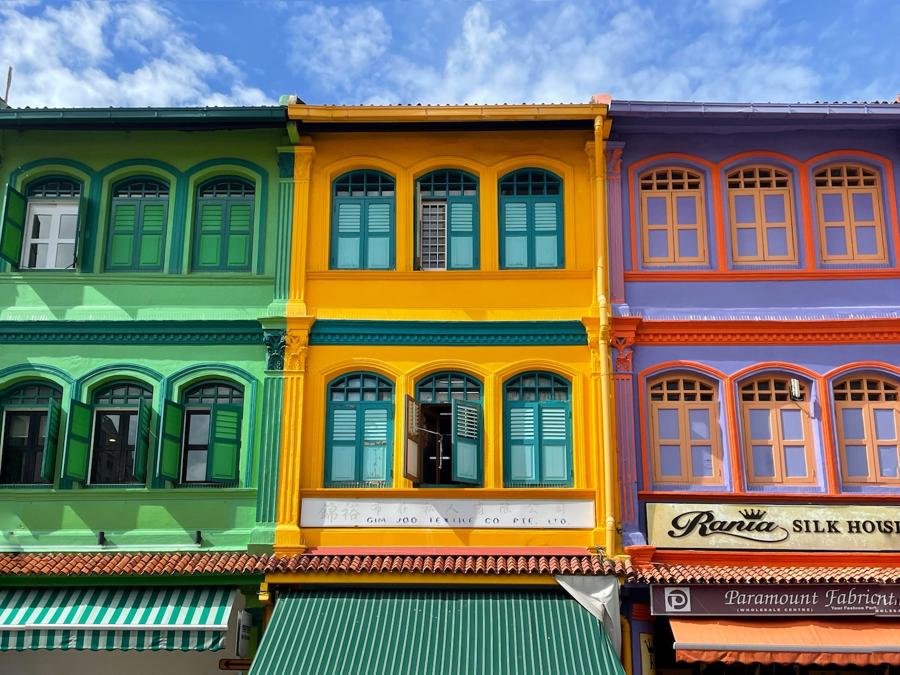
Joo Chiat
Visiting Hong Kong? Here's a similar guide to Hong Kong's best restaurants and bars.
Visiting Shanghai? Here's a similar guide to Shanghai's best restaurants and bars.
Visiting Bangkok? Here's a similar guide to Bangkok's best restaurants and bars.
Visiting Phnom Penh? Here's a similar guide to Phnom Penh's best restaurants and bars.
Visiting Macau? Here's a similar guide to Macau's best restaurants and bars.
Visiting Shenzhen? Here's a guide to Shenzhen's top 5 must visit destinations.

My name is Sophie Steiner, and welcome to my food-focused travel blog. This is a place to discover where and what to eat, drink, and do in Shanghai, Asia, and beyond. As an American based in Shanghai since 2015 as a food, beverage, travel, and lifestyle writer, I bring you the latest news on all things food and travel.
Your email address will not be published.
Be the first to comment!